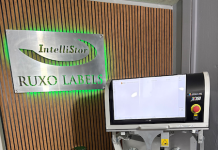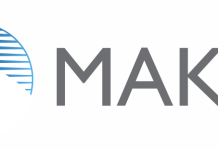Finding the right press requires consideration of a number of factors, with the choice between two digital printing technologies – inkjet and electrophotography (toner) – being the first step. Julie Cross, DP Technical Director at Domino Printing Sciences (Domino), takes a closer look at both technologies to support informed decision-making about which press may be best suited to different businesses’ needs.
The digital packaging printing market continues to grow, projected to reach nearly $36 billion by 2026, with many converters looking to invest in a digital printing press to harness the technology’s efficiency, flexibility and business management benefits – among others.
Inkjet Printing Technology
Inkjet printing was invented in the 1950s and uses software, hardware and printing ink to reproduce digital images on a substrate. The process involves deconstruction of the artwork into a pattern of dots, which is then recreated by printhead nozzles, placing ink droplets onto the substrate.
Colour digital inkjet printing presses use multiple printheads and nozzles to dispense different coloured inks into a single, seamless design. Inks are composed of colour pigments suspended in a carrier liquid, which are blended on the substrate to recreate a wide variety of different colours and tones.
Thanks to the capability to precisely control ink drop size, digital inkjet printing allows for the production of finely detailed designs, such as smooth gradients, micro print and detailed Asian characters. Ink composition, viscosity, drop speed, and substrate absorption properties are all factors that affect ink laydown and colour blending.
In UV inkjet printing, inks are partially set in place by a pinning lamp during the print process and then cured to create a durable, high-quality finish.
Toner Printing Technology
Toner printing – also known as electrophotography – was first developed in 1938. The technique uses software, hardware and dry or liquid toner to reproduce a digital image on a drum, which is then transferred to the substrate. It is most frequently used commercially in office photocopiers and laser printers.
Colour toner printing is a digital offset printing process: the artwork is converted into colour separations, reproduced as electrostatic fields on an imaging drum. Electrically charged toner particles are drawn to these fields, creating single-colour images.
The toner formulation, as well as the contact printing and fusing process, mean that toner doesn’t penetrate the substrate to maximise adhesion. Therefore, toner labels often require varnish or lamination to ensure durability. The limited bonding of toner with the substrate also means that not all substrates are suitable for toner printing. Synthetic substrates, for example, require pre-treatment to ensure toner adhesion.
Evaluating Performance
While both inkjet and toner printing technology have their merits and deliver high print quality, in printing houses where both technologies are available, converters often prefer UV digital inkjet printing. There are several reasons:
Colour Consistency
OEMs require brand-compliant colour representation in all their labels. As a non-contact printing technology, inkjet offers excellent print colour consistency, with a high tolerance for fluctuating environmental factors, such as changes in temperature and humidity.
In contrast, changes in temperature and humidity are more likely to affect the reliability of the static charge in toner print technology, negatively impacting print colour consistency.
Print Durability
The aesthetic appeal of a product label is important to brand owners – not just at the point of sale but throughout the product’s entire lifecycle. Equally, where expiry dates, allergens, or safety caution symbols are included, label durability is critical for regulatory compliance.
A UV digital inkjet printing process delivers consistent ink curing, with good adhesion to a wide range of substrates, creating a finish that offers long-term durability. After curing, UV inkjet labels are resistant to scuffing and scratching, offer good tolerance to environmental factors such as exposure to heat, water, and chemicals, and have high lightfastness.
This durability is achieved without additional coatings such as varnish or lamination, typically needed with toner printing. Converters with access to both technologies can, therefore, save money on more demanding applications by opting for inkjet labels.
Productivity
Productivity is one of the main criteria converters consider when comparing digital label presses, and inkjet typically wins when it comes to speed. According to ‘Smithers. The Future of Digital Print for Packaging to 2026. 2021’, both the inkjet and toner printing systems on the market today are capable of running at high speeds. However, digital inkjet printing technology has an inherent capacity to run faster, as it doesn’t need physical contact with the substrate to produce an image.
With most inkjet presses it is possible to increase printing speed by lowering the print resolution, with analysts predicting higher speeds maintaining high resolution will be possible as printhead technology progresses.
Speed improvements are more difficult to achieve with toner print technology, as speed often depends on the toner particle size, coverage and number of colours used – affecting the transfer speed and required fusing time.
Cleaning And Maintenance
Regular cleaning of printing components ensures consistent print quality and avoids unwanted transfer. Inkjet press maintenance tasks such as nozzle cleaning and capping and printhead alignment and registration can be readily automated with onboard tools, whereas cleaning and re-calibrating a toner press can be a more time-consuming affair, requiring a skilled operator.
Smithers’ The Future of Packaging to 2026 analysis reports typically lower uptime for converters using toner versus inkjet printing technology, affecting overall productivity and ROI.
Cost Of Ownership
Cost of ownership is another key consideration for converters, and consumables account for a large share of the regular running cost.
Converters having access to both technologies often use their toner press when producing labels with high coverage, as the ‘click charge’ – a flat rate charged for each rotation of the imaging drums as part of their lease to cover maintenance and consumable cost – remains the same, regardless of how much toner is applied, making toner the more economical option. However, inkjet is often the preferred option for applications with average or low coverage, as ink cost is lower for these applications.
While both technologies have their merits, based on the comparison above, inkjet seems the better choice for a label converter looking to the future. However, before making a final choice, it is important for any converter to engage with a print technology provider to explore the needs of their customers’ label applications.





















